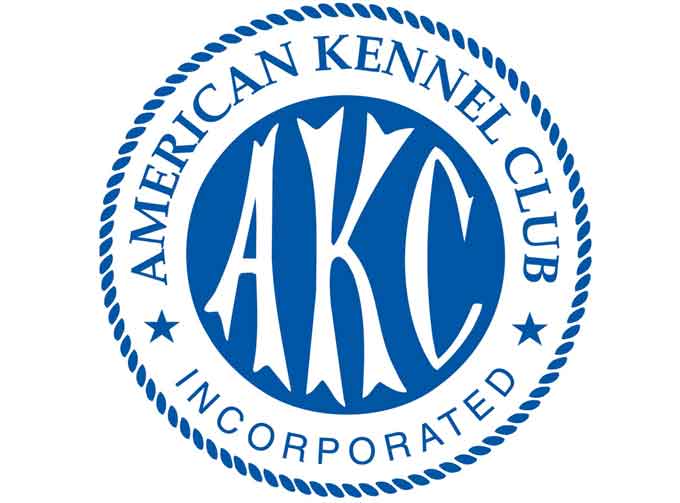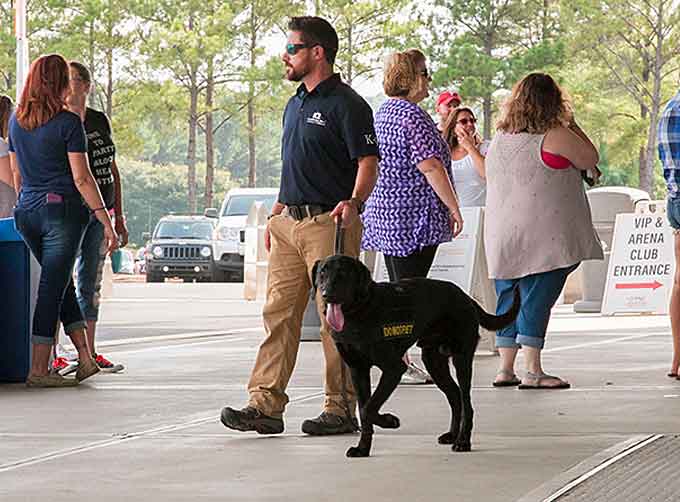
The American Kennel Club will host the 2018 AKC US Dog Detection Conference Tuesday, August 28th – Thursday, August 30th, 2018 in Durham, NC to explore solutions to the shortage of domestic dogs for explosives detection in the United States.
The Conference will bring together stakeholders in this national security issue including: Breeders, Trainers, Government, Law Enforcement, Academia, vendors, businesses, and more.
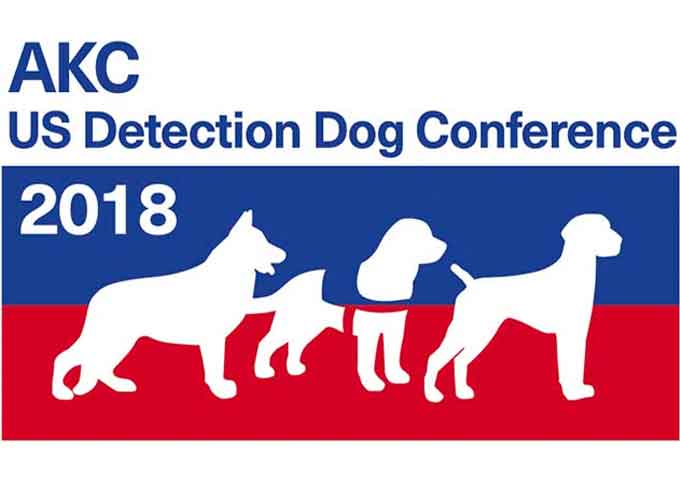 The American Kennel Club formed a task force three years ago to explore how the AKC and breeders that register with the AKC, might help with the increasing demand for qualified dogs to do this important task and enhance national security.
The American Kennel Club formed a task force three years ago to explore how the AKC and breeders that register with the AKC, might help with the increasing demand for qualified dogs to do this important task and enhance national security.
With incidents of homegrown terrorism and mass shootings on the rise, explosives detection is a growing need for government agencies and private businesses.
Dogs have amazing scenting capabilities and are the best explosives detectors.
(Learn More. Meet “K9 Pablo” is a nine-year-old Belgian Malinois Military Working Dog (MWD), who is a certified PEDD (Patrol/Explosive Detection Dog) by the US Air Force, and is assigned to the Marine Corps Police Department in Albany, Georgia. Pablo regularly serves on Secret Service details for visiting dignitaries. Pablo has provided protection for President Obama, Vice President Biden, Former President Clinton and Former Secretary of State Hillary Clinton. Pablo also regularly attends Sunday morning church service at Maranatha Baptist Church in Plains, Georgia to help protect Former President Carter while he teaches Bible Study. Pablo participates in nearly every career day at the local schools, and many non-profit and charity events in his local community. Courtesy of the American Kennel Club and YouTube.)
The United States has relied on Europe for most of its working dogs and is now facing a shortage of dogs for detection work, due to increased overseas demand for detection dogs.
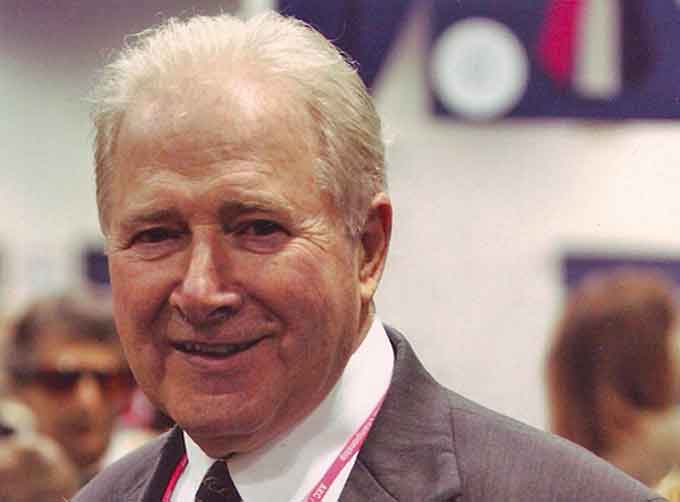
“Dogs play a very important role in several aspects of our security on the local, national and international levels,” says Dr. Carmen Battaglia, AKC Detection Dog Task Force Project Leader & AKC Board Member.
“As the oldest and largest dog registry in the country, we felt that it was important to be of assistance by bringing awareness to this issue, educating breeders and fostering a collaboration that will hopefully lead to viable solutions.”
(Learn More. ACE Search and Rescue Dog Honoree: K-9 “Patella,” a Labrador Retriever owned by Jim Houck of Ft. Collins, Colorado. Courtesy of the American Kennel Club and YouTube.)
The conference will cover a range of topics that include scentwork, genetics, breeder education, public policy, the current scope of dog detection, etc., and include a detection dog demonstration.
SPEAKERS INCLUDE:
- Dr. David Adebimpe, Founder/CEO of ScentLogix
- Dr. Carmen Battaglia, AKC Detection Dog Task Force Project Leader & AKC Board Member
- Dr. Matthew Breen, Professor of Genomics, NC State University of Veterinary Medicine
- Dr. Candace Croney, Director, Purdue University Center for Animal Welfare Science
- Mark Dunn, Executive VP, The American Kennel Club
- Sheila Goffe, Vice President, AKC Government Relations
- Pamela Haney, MS, Canine Performance R&D Manager, Canine Performance Sciences Program at Auburn University College of Veterinary Medicine
- Dr. Brian Hare, professor of evolutionary anthropology, Duke University, and founder, Dognition
- Fred Helfers, Founding President, Pacific Northwest Police Detection Dog Association; Owner, FH Consulting / Canine Detection Services
- John P. Kerwick, President (Region 7) United States Police Canine Association (USPCA); Tactical Commander, Metropolitan Transportation Authority Police Canine Unit, New York City
- Jane Messineo Killion, Founder, Puppy Culture, When Pigs Fly Dog Training and Madcap Bull Terriers
- Lane Kjellsen, Chairman and CEO, K2 Solutions
- Dave Kontny, Chief of Staff, Joint Program Office for Countering IED, Federal Bureau of Investigation
- Wendell Nope, K-9 Training Supervisor, Utah Department of Public Safety
- Dr. Cindy Otto, Founder/Director, Penn Vet Working Dog Center
- John C. Pearce, Director of Operations, VWK9
- Commissioner Larry B. Perkins, CFE, CPP, CMP,Vice President and Assistant General Manager, PNC Arena/Carolina Hurricanes
- Andrew Ramsey, Founder, Ramsey K-9 Services
- Scott Thomas, Former breeding program manager, TSA
- Dr. L. Paul Waggoner PhD, Co-Director of the Canine Performance Sciences Program and an adjunct associate professor in the Department of Anatomy, Physiology, and Pharmacology at Auburn University College of Veterinary Medicine
- Stacey West, Canine Operations Manager, K2 Solutions
Why is there a shortage of domestic detection dogs?
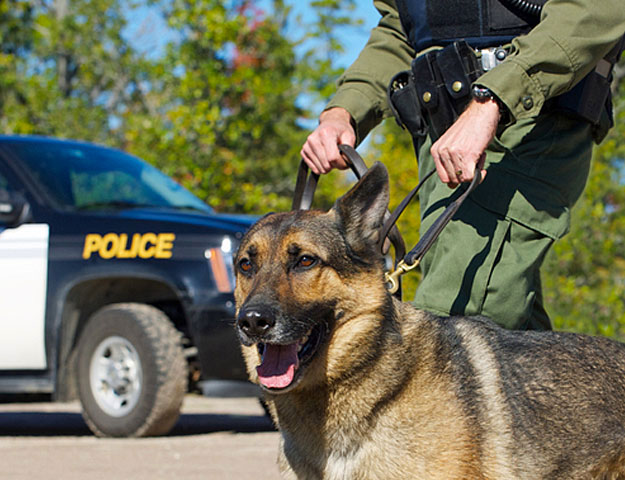 Following the events of 9-11, the demand for scent detection dogs for use in search and rescue, as well as explosives detection, began to grow and has steadily risen since.
Following the events of 9-11, the demand for scent detection dogs for use in search and rescue, as well as explosives detection, began to grow and has steadily risen since.
Recent events, including the 2016 bombings in Brussels and New York City, have accelerated the interest in detection dogs.
Nowadays, it is not just governments and militaries that are seeking dogs.
Non-governmental demand across the developed world is also increasing, especially by private entities tasked with protecting malls, movie theaters, sports complexes, schools and universities.
Most U.S. government agencies are relying almost exclusively on the importation of working dogs from Europe to meet their needs.
Most private working dog trainers and private providers of security services in the U.S. are also dependent on European sources.
American experts in the importation and training of working dogs claim that for many years the U.S. has received less than the best picks of the litters in Europe, as the best dogs tend to be retained for use in Europe.
However, due to the growing terrorism threats and consequent demand for working dogs within Europe and around the world, there is now a shortage of even mediocre quality foreign dogs available to protect the United States.
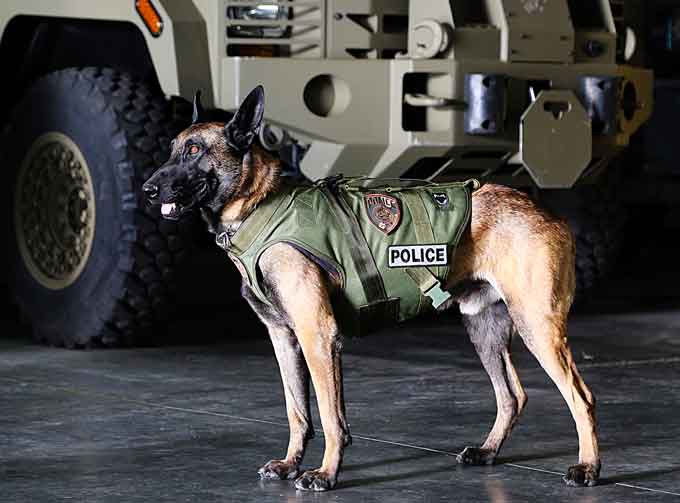
U.S. Department of Homeland Security and Department of Defense (DOD) officials say there is a need to develop a national source of dogs that meets the standards for this work and that can be made available to government agencies.
There are currently an estimated 10,000 working dogs in the United States, including dogs working in government, military, law enforcement, and private facilities.
About 20 percent of working dogs retire each year.
Working dogs typically go to work at 18 months to 2 years of age and have an average working life of five years before retirement.
The DOD operates a small breeding program, primarily for Belgian Malinois, at its kennels at Lackland Air Force Base in San Antonio, TX, but the program cannot meet the total need so the DOD purchases most of its dogs in Europe.
The Transportation Security Administration (TSA) had its own detection dog breeding program for primarily Labrador Retrievers until shutting it down in 2012 due to budget cuts.
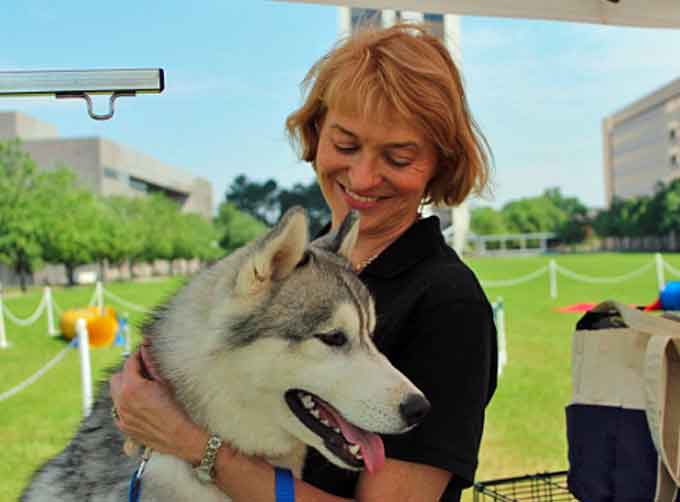
AKC Vice President of Government Relations Sheila Goffe testified at a congressional hearing in October regarding the dire need for more dogs to protect the country.
“Experts recognize that there is no better or more efficient way to detect explosives than through the use of high quality, specially trained scent detector dogs.”
“Since the terrorist attacks on 9-11, and subsequent attacks worldwide, global demand for high quality explosives detection dogs has skyrocketed,” Goffe said.
“A shortage of appropriate, domestically-bred dogs available for work as explosive detection dogs presents a significant threat to U.S. security.”
Why is the American Kennel Club involved in this issue?
The AKC Board of Directors formed a task force to study this issue and how AKC could assist after receiving requests for help from government and academic officials.
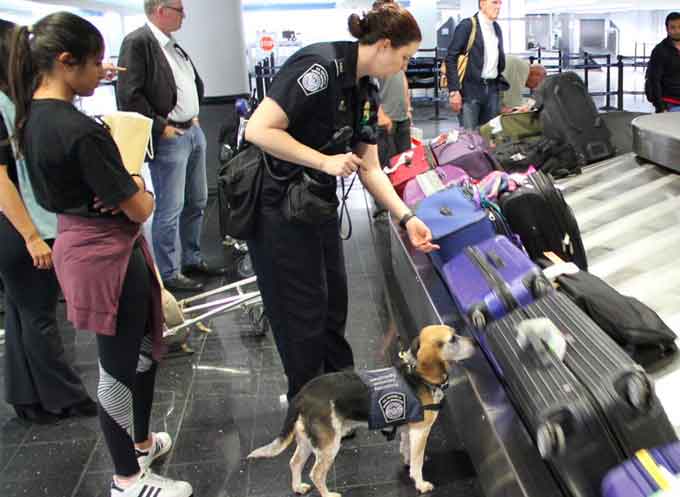
AKC has always been a leader in purpose-bred pure-bred dogs, and it is purpose-bred pure-bred dogs that have the skills, ability and breeding to produce the traits needed for detection dogs to successfully do their important jobs.
It is a natural role for AKC to assist in meeting this national need to protect our country, and a great opportunity to promote the incredible abilities of pure-bred dogs.
The AKC’s support of this issue demonstrates to the American public that purebred dogs bred by thoughtful, purposeful, American breeders are vital to the safety and security of their country.”
How is AKC working to solve the shortage?

The AKC Detection Dog Task Force is helping spread awareness of the issue with breeders of the most in-demand dogs.
The Government Relations team is working to change government policy to make it easier and more advantageous for breeders to sell dogs to the government and make the government more accountable for the amount they are paying to import European dogs.
AKC also has helped bring the many interested parties together to discuss this issue through the AKC US Detection Dog Conference.
What breeds are most in demand for detection dog work?
Sporting breeds are the most in demand for explosives detection work in public settings.
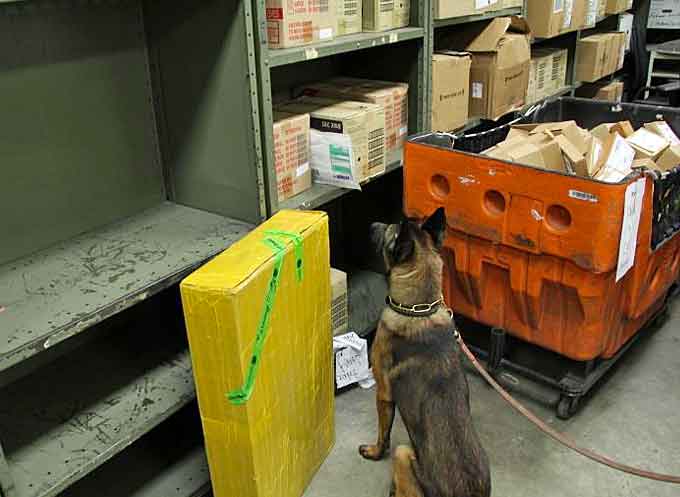
Breeds that excel at the work include Labrador Retrievers, German Shorthaired Pointers, German Wirehaired Pointers, Vizslas and Golden Retrievers.
Sporting breeds have been found to be less intimidating to the public and their keen noses and hunting ability are easily transferred to the search for explosives.
German Shepherd Dogs and Belgian Malinois are still the preferred breeds for patrol work and dual-purpose patrol/detection dogs.
At what age are the dogs purchased for detection dog training?
The US Government and most private detection dog training schools seek older puppies that are at least 10 months old, with 12 months being preferable.
Some private programs are now accepting younger puppies since it can be more difficult to get older puppies that have also had the desired early socialization and foundation training.
What is a “green “dog and is it defined in writing somewhere?
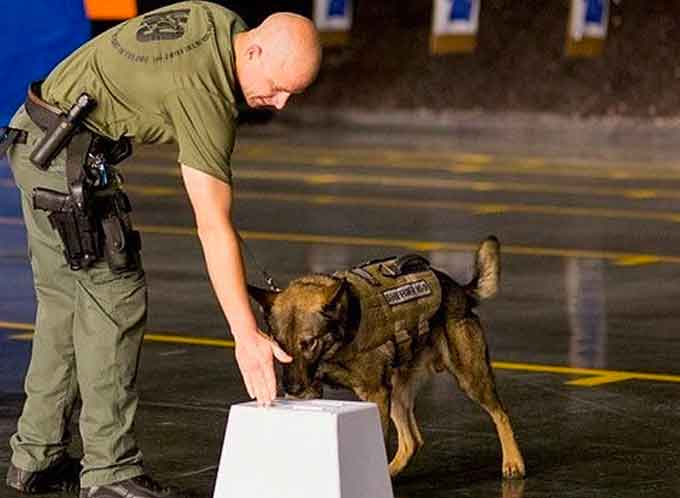
A green dog is an informal term used to describe a dog that has not undergone advanced detection work training.
It is not defined in the government requirements for potential detection dogs.
Most dogs presented to the government for sale at around 1 year of age are categorized as green dogs.
This does not mean that a “green” dog has not received any training.
They are expected to have been prepped for the government evaluation which includes socialization to a variety of people and places; exposure to walking on different surfaces, steps and elevated areas; and has developed toy drive for a ball, Kong or another toy.
What is the government willing to pay for a puppy and at what age will they purchase them?

The government will evaluate dogs starting at about 10 months of age and average price for a “green” dog is about $8,000.
Private detection dog schools also purchase candidates and some take younger dogs, including puppies as young as 8 weeks.
Prices vary from private channels, depending on age, pedigree and other factors.
Where will the pups be taken for evaluation? Do I ship them or they do pick them up?
The TSA and Department of Defense conducts evaluations at its training center at Lackland Air Force Base in San Antonio, Texas.
It is up to the seller to bring the dog to Lackland, where the dog will be left for evaluation for up to 10 days. At this time, only brokers with government contracts can sell to the government.
Private vendors do buy from private breeders and have different requirements, and many do travel to kennels around the country to evaluate dogs.
Who is your go-to person for questions and help?
Penny Leigh is the project manager of the AKC Detection Dog Task Force and can assist you.
She may be reached at pxl@akc.org or 919-816-3749.
To Learn More about conference opportunities and a complete list of speakers, please visit www.akc.org/edc.
Founded in 1884, the American Kennel Club is a not-for-profit organization which maintains the largest registry of purebred dogs in the world and oversees the sport of purebred dogs in the United States.
Learn More…
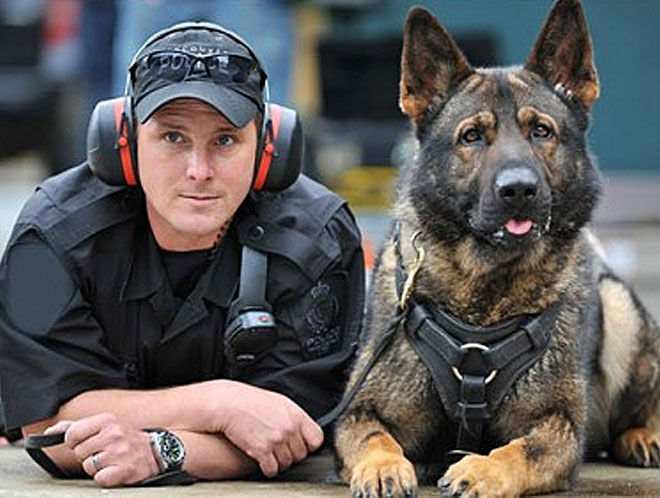
RCMP Wins 2017 ‘ASTORS’ Award for Fentanyl Dog Training (Multi-Video)
The Royal Canadian Mounted Police’s Police Dog Service Training Centre (PDSTC) was honored at the 2017 ‘ASTORS’ Homeland Security Awards ceremony in New York for its innovation in the fight against illicit fentanyl.
 Recognized for developing a technique that safely trains dogs to detect the powerful opioid, the PDSTC earned a Platinum ‘Excellence in Homeland Security’ Award.
Recognized for developing a technique that safely trains dogs to detect the powerful opioid, the PDSTC earned a Platinum ‘Excellence in Homeland Security’ Award.
The ceremony was organized by American Security Today, a digital publication platform that profiled the technique after the RCMP announced it would train all of its 139 narcotics-profile dogs across Canada.
The efforts of our neighbors to the North can only benefit the US and strengthen our combined efforts along our northern border.
And their training is paying off.
(Akrum Ghadban, Officer in Charge, Royal Canadian Mounted Police Dog Service Training Centre (at right) – being interviewed by Dr. Kathleen Kiernan, Founder and Chief Executive Officer, Kiernan Group Holdings, on behalf of AST. Courtesy of American Security Today and YouTube)
“I do believe the Canadian population is safer because of our new fentanyl dog training.”
“By keeping more fentanyl off the street, we save Canadian lives,” says Inspector Akrum Ghadban, Officer in Charge of the RCMP Police Dog Service Training Centre (PDSTC) in Innisfail, Alberta.
The RCMP leads the way in dog training to detect fentanyl.

(Image courtesy of the RCMP)
It is particularly efficient, making the dogs in the field extremely productive,” explained Staff Sergeant Eric Stebenne, Senior Trainer at the RCMP PDSTC.
“Our specialists have transformed pure fentanyl into a diluted liquid form, enabling our dogs to train with the real smell of fentanyl with no risk of inhaling it.
RCMP specialists transform pure fentanyl into a diluted liquid form, which allows the dogs to train with the scent of real fentanyl without risk of inhaling it, rendering the technique safe and efficient and making the dogs extremely productive in the field.
During police operations, the dogs can detect fentanyl from a safe distance and dog handlers are trained to administer an antidote to canines who may inadvertently come into contact with the drug.
(See the process of diluting fentanyl into liquid form to be used safely, for RCMP Police Service Dog training to detect fentanyl. Courtesy of RCMP and YouTube)
“Illegal opioids are a major concern around the world as a public safety issue,” added Inspector Ghadban.
“Last year, in Canada alone, law enforcement seized about 18 kilograms of fentanyl, which is significant considering just a few grains can cause an overdose.”
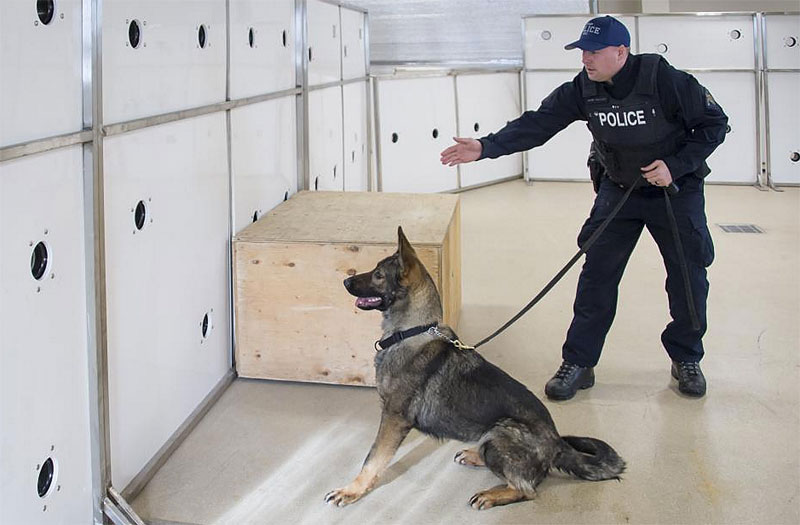
“It is an honor to accept this award on behalf of the Royal Canadian Mounted Police.”
“I’m very proud of our work as a team in developing this training program and sharing it with other law enforcement partners.”
In February, the RCMP held a two-day workshop on canine fentanyl detection, hosting 35 participants from across North America at the PDSTC, located in Innisfail, Alberta.
Fentanyl is an opioid approximately 100 times more potent than morphine which can cause serious harm, including death, when used improperly.
It has been distributed illegally in many forms, including in tablets made to look like prescription drugs.
Risks to Law Enforcement
In addition to being deadly to users, fentanyl poses a grave threat to law enforcement officials and first responders, as a lethal dose of fentanyl can be accidentally inhaled or absorbed through the skin.
The DEA released the following Police Roll Call video nationwide to warn law enforcement about this danger.
(‘FENTANYL – A Real Threat to Law Enforcement,’ courtesy of the DEA, the Department of Justice, and YouTube)
The onset of adverse health effects, such as disorientation, coughing, sedation, respiratory distress or cardiac arrest is very rapid and profound, usually occurring within minutes of exposure.
If inhaled, move to fresh air, if ingested, wash out mouth with water provided the person is conscious and seek immediate medical attention.
Narcan (Naloxone), the overdose-reversing drug, is an antidote for opiate overdose and may be administered intravenously, intramuscularly, or subcutaneously.
Immediately administering Narcan can reverse an accidental overdose of fentanyl exposure to officers.
Continue to administer multiple doses of Narcan until the exposed person or overdose victim responds favorably.
Canine units are particularly at risk of immediate death from inhaling fentanyl.
(In Florida a police dog named Primus accidentally overdosed after coming in contact with the drug Fentanyl during an October police raid, which has led to changes in the way Police approach narcotics investigations. Courtesy of Wochit News and YouTube)
Field Testing / Safety Precautions
Law enforcement officers should be aware that fentanyl and its compounds resemble powered cocaine or heroin, however, should not be treated as such.
If at all possible do not take samples if fentanyl is suspected. Taking samples or opening a package could stir up the powder.

If you have reason to believe an exhibit contains fentanyl, it is prudent to not field test it.
If you must take a sample, use gloves (no bare skin contact) and a dust mask or air purifying respirator (APR) if handling a sample, or a self-contained breathing apparatus (SCBA) for a suspected lab.
Submit the material directly to the laboratory for analysis and clearly indicate on the submission paperwork that the item is suspected of containing fentanyl.
This will alert laboratory personnel to take the necessary safety precautions during the handling, processing, analysis, and storage of the evidence.
Officers should be aware that while unadulterated fentanyl may resemble cocaine or heroin powder, it can be mixed with other substances which can alter its appearance.

potential dangers to first responders. For instance with suspected narcotics,
which could potentially be life-threatening fentanyl or fentanyl-class substances.
As such, officers should be aware that fentanyl may be smuggled, transported, and/or used as part of a mixture.
Universal precautions must be applied when conducting field testing on drugs that are not suspected of containing fentanyl.
Despite color and appearance, you can never be certain what you are testing.
In general, field testing of drugs should be conducted as appropriate, in a well ventilated area according to commercial test kit instructions and training received.
Sampling of evidence should be performed very carefully to avoid spillage and release of powder into the air.
At a minimum, gloves should be worn and the use of masks is recommended. After conducting the test, hands should be washed with copious amounts of soap and water.
Never attempt to identify a substance by taste or odor.
Carfentanil: A Dangerous New Factor in the U.S. Opioid Crisis (DEA Officer Safety Alert)
Carfentanil is a synthetic opioid approximately 10,000 times more potent than morphine and 100 times more potent than fentanyl.
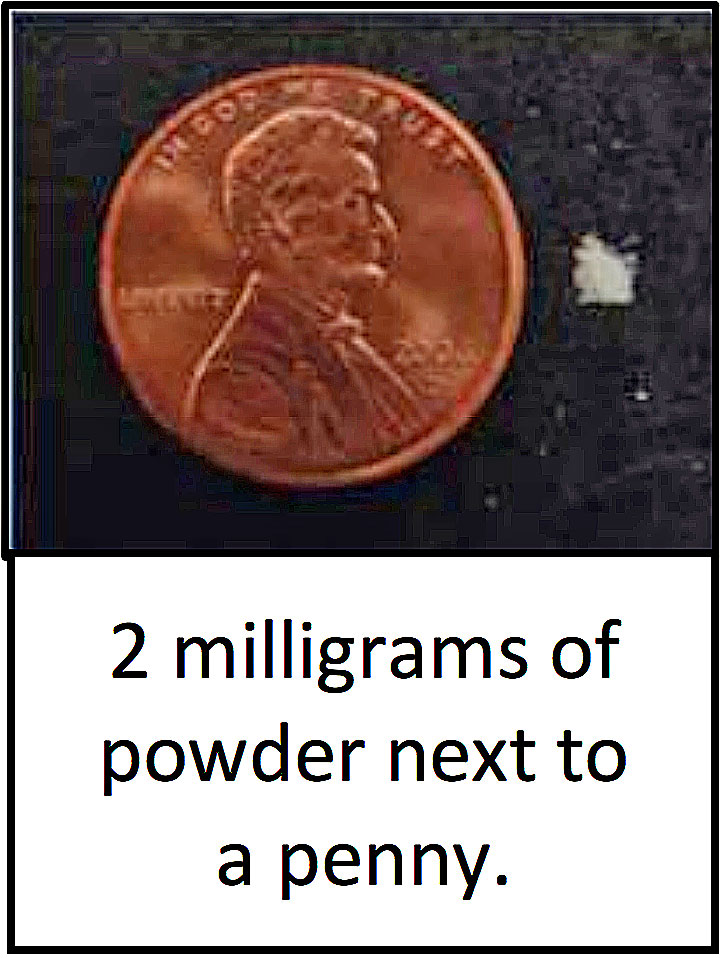
The presence of carfentanil in illicit U.S. drug markets is cause for concern, as the relative strength of this drug could lead to an increase in overdoses and overdose-related deaths, even among opioid-tolerant users.
Carfentanil is used as a tranquilizing agent for elephants and other large mammals.
The lethal dose range for carfentanil in humans is unknown; however, carfentanil is approximately 100 times more potent than fentanyl, which can be lethal at the 2- milligram range, depending on route of administration and other factors.
The 2018 ‘ASTORS’ Homeland Security Awards Program
AST focuses on Homeland Security and Public Safety Breaking News, the Newest Initiatives and Hottest Technologies in Physical & IT Security, essential to meeting today’s growing security challenges.
 The 2018 ‘ASTORS’ Homeland Security Awards Program, is organized to recognize the most distinguished vendors of Physical, IT, Port Security, Law Enforcement, Border Security, First Responders, (Fire, EMT, Military, Support Services Vets, SBA, Medical Tech) as well as the Federal, State, County and Municipal Government Agencies – to acknowledge their outstanding efforts to ‘Keep our Nation Secure, One City at a Time.’
The 2018 ‘ASTORS’ Homeland Security Awards Program, is organized to recognize the most distinguished vendors of Physical, IT, Port Security, Law Enforcement, Border Security, First Responders, (Fire, EMT, Military, Support Services Vets, SBA, Medical Tech) as well as the Federal, State, County and Municipal Government Agencies – to acknowledge their outstanding efforts to ‘Keep our Nation Secure, One City at a Time.’
To Learn More about the ‘ASTORS’ Homeland Security Awards Program, see 2017 ‘ASTORS’ Homeland Security Award Winners Honored at ISC East.

Over 100 distinguished guests from National, State and Local Governments, and Industry Leading Corporate Executives from companies allied to Government, gathered from across North America and the Middle East to be honored from disciplines across the Security Industry in their respective fields which included representatives from:
 The Department of Homeland Security(DHS) Science and Technology Directorate (S&T)
The Department of Homeland Security(DHS) Science and Technology Directorate (S&T)- U.S. Customs and Border Protection
- The Department of Justice
- The Security Exchange Commission
- State and Municipal Law Enforcement Agencies
- The Royal Canadian Mounted Police
- Leaders in Private Security













